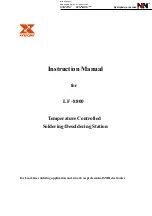
Troubleshooting Guide
!
WARNING:
Disconnect the Power Plug before
servicing. Failure to do so may result in electric
shock. If Power Cord Assembly is damaged, it must
be replaced by the manufacturer, or its service agent
to avoid personal injury or damage to the unit.
Problem
Check
Cause & Action
The Heater Indicator is
not lit up
The Heater Indicator is
lit up but the Tip does
not heat up
The Tip heats up
intermittently
1) Is the Power Cord and/or
connecting plug disconnected?
2) Is the Fuse blown?
3) Is the Soldering lron Cord
broken?
4) Is the Heating Element
broken?
Check 3)
Connect it
Determine why the Fuse was
blown and eliminate the cause,
then replace the Fuse
Is the inside of the Soldering
Iron short-circuited?
Is the Grounding Spring touch-
ing the Heating Element?
Is the Heating Element Lead
Wire twisted and short-
circuited?
Is the PWB already damaged?
Refer to “Checking for Breakage
of the Heating Element & Cord
Assembly”
1
2
3
The Tip is not wet
5) Is the Tip temperature too
high?(
[
])
770
410
Set an appropriate
temperature
4
6) Is the Tip clean?
A. Refer to “Use and Care of
Tips”
B. Working surfaces not well
tinned during idling periods
C. Lack of flux in soldering,
wicking, repairing and touch-
up operations
D. Wiping Tip on high sulphur
content Sponges, dirty or dry
Sponges and rags
E. Contacting with organics,
such as plastic resins,
silicone grease, and other
chemicals
F. Impurities in solder and low
tin
7) Is the Tip coated with
oxides?
Refer to “are and Maintenance
of Soldering lron.”
8) Is Iron temperature
calibrated correctly?
Refer to “Calibrating the Iron
Temperature.”
9) Is the Tip seized?
Is the Tip swollen because
of deterioration?
Replace the Tip and the
Heating Element.
Check 8)
Check 8)
10) The indicator is not lit at all or
it stays orange for long period
of time
PWB is damaged
5
The Tip temperature is
too low
6
The Tip cannot be
pulled off
7
8
The Tip does not hold to
the desired temperature
The Tip temperature is
too high
17.
A.
B.
C.
D.
Specifications
Control Base
Model #
Description
Power Consumption
Output Voltage
Temperature
Dimension of Control Base
Dimension of Iron Holder
Weight (Ele. Cord not included)
Fuse
SGS-2000
SGS-2005
SGS-2010
SGS-2015
Standard
ESD Safe
AC 200-240V ~ 50Hz 6W
AC 90-125V ~ 60Hz 60W
24V
392-896 F (200-480 C)
L x W x H = 5.7 x 4.3 x 1.8” (145 x 110 x 45mm)
Standard
ESD Safe
L x W x H = 5.7 x 3.6 x 2.8” (145 x 91 x 70mm)
2 lb (< 1kg)
250V-T-1A (
250V-T-2A (
F
5 x 20)
F
5 x 20)
Soldering Iron
Model #
Input Voltage
Tip to Ground Resistance
Tip to Ground Potential
Heating Element
ESD Safe
SGI-900
SGI-901
24V
< 2
< 2mV
Ceramic Heater
No
Yes
W
The above specifications and design are subject to change without notice.
18.
Soldering lrom Temperature Curve
Schematic Diagram
(Figure 20)
(Figure 21)
500
450
400
350
300
250
200
150
100
50
H: 65sec
O: 180sec
D: 60
D: 18
T: Room Temperature 25
H: Heat-Up Time
O: Operating Time
R: Thermal Recovery Time
D: Temperature Drop
Test Criteria
1. Soldering Tip: SGT-716D
2. Epoxy Resin Board
3. Solder: 1.6 5mm
4. Cycle: Every 3 Seconds
F
1
2
3
4
5
6
7
Minute
AC Input
EMC
Filter
Rectified Phase
Correction Filter
Zero
Voltage
High Frequency
Switch
Transformer
Circuit
High Frequency
Rectified Circuit
Low-pass
Circuit
Heating
Element
Temperature
Sensor
COMP
Setting
Grounding
Starting
Circui
19.




















